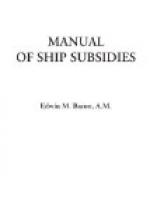In 1898 a Government commission, appointed to consider and report upon the state of the empire’s mercantile marine, declared that Russia was losing a vast sum annually through the lack of a sufficient commercial fleet of her own, and yet no progress seemed to be making toward increasing her tonnage. To remedy this unsatisfactory condition the commission suggested the removal of the duty on ships built abroad for Russia, and the free admission of all material necessary for ship construction.[ER]
Favoring laws followed. By a measure of July that year (1898) ships bought abroad, if destined for the foreign sea-borne trade, were exempted for a period of ten years from the heavy duties levied on such vessels.[EQ] The next year (1899) the coasting trade, reserved exclusively for Russian ships, was extended to include navigation between any two Russian ports in any seas; and, further to restrict this trade to subjects of the empire, it was enacted that ships engaged in it must be manned exclusively by Russian officers and seamen.[EQ]
At this period Russia’s shipping industry, outside the Government works for the construction of battle-ships, was of comparatively little consequence. In the few extensive ship-yards river steamers, tugs, and other small craft, built from Russian materials and by Russian workmen, were chiefly turned out. The materials could be bought cheaper abroad, but Russian labor was cheaper. According to the United States consul at St. Petersburg, the wages of common workmen were then from fifty-one to sixty-four cents a day, while skilled workmen were receiving but seventy-seven cents to one dollar a day.[ES]
In the decade 1890-1901 the amount of subsidies expended directly to encourage shipping increased rapidly, and the tonnage increased in extent and importance. In 1890-91 the total tonnage stood at 427,335 tons of which 156,070 were steam and 271,265 sailing ships. In 1902-03 a total of 800,334 tons was reached, of which 556,102 were steam and 244,232 sailing ships.[ET]
In 1902 the granting of bounties in the form of loans to ship-owners was proposed, with the object of inducing them to buy Russian ships built of Russian materials instead of foreign product. The scheme contemplated a mortgage on the finished ship at fifty per cent of the actual cost, without interest, to cover a period of twenty years, the loans to be in equal yearly payments. The amount of the bounty was to depend upon the difference between the cost of home-built and foreign-built ships. The loans were to be made only on first-class sea-going steamers. The plans and specifications were to be approved by the minister of finance before building; and steamers of over one thousand tons register must show an average speed of not less than ten knots on a six hours’ trial; those under one thousand tons, of not less than eight knots. In addition to the loans the Government was to bear part of the expense of insurance. To facilitate the export of Russian goods in Russian-built ships, a rebate was allowed of half the expense of Russian coal used in steamers carrying less than three-fourths of a full cargo on export, and one-half cargo on import. It was estimated that this scheme for fostering domestic shipbuilding would entail smaller drafts on the national treasury than would the granting of direct construction and navigation premiums.[EU]




